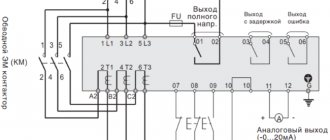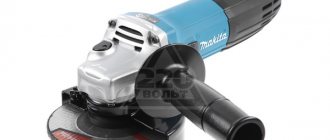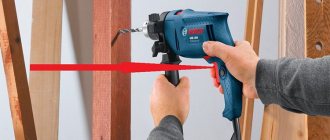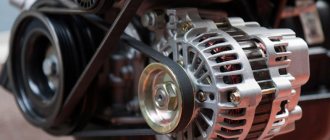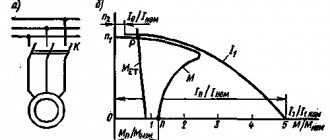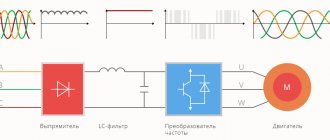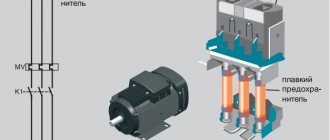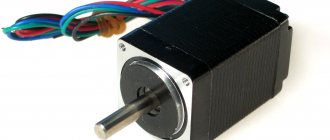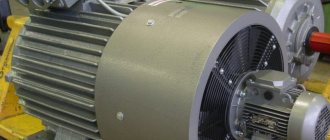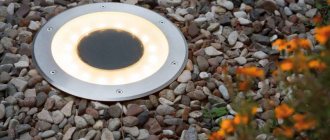Soft start devices (Soft starters) are designed for smooth acceleration and deceleration of electric motors, limiting inrush currents at the time of start-up and matching the load torque with the engine torque.
It is no secret that asynchronous motors, when starting, have high starting currents, exceeding 6-8, and in some cases even 10 times, the rated current and a significant increase in torque, which negatively affects the operation of the motors themselves. In addition, this leads to a voltage drop in the supply networks, which in turn affects the operation of other electrical equipment.
There are several options to solve this problem. Most often, this is done by connecting the motor according to the “Star-Delta” scheme, through soft starters and frequency converters. In this article we will consider only UPP, but I will briefly talk about the other two options.
Starting according to the star-delta circuit is carried out as follows - during the initial period of engine acceleration, its windings are connected by a star, which provides a reduced current. After a certain time set by the time delay relay, it switches to delta, which provides full current and torque.
This method is effective when starting the engine either without load or with an easy start. When starting the engine under heavy load, this method is not applicable. Also, this circuit can only be used with motors whose windings are designed for a mains voltage of 380/660V.
The use of frequency converters makes it possible to ensure that the engine will already operate at the rated current and with the rated torque at the moment of starting. Also, the use of a frequency drive allows for a smooth stop of the engine, in contrast to the star-delta circuit, where the only way to stop can be direct stop.
The use of a frequency converter is justified in cases where motor speed control is required. If regulation is not required, then the optimal solution would be to use soft starters.
Thanks to these devices, it is possible to avoid problems associated with starting, ensure a smooth start of motors with limited starting current and angular acceleration, and adjust the engine acceleration and deceleration time. All this helps to increase the service life of equipment and stabilize voltage in networks.
In addition, a number of different protection functions are built into soft starters -
- Protection against loss of input phase and output phase
- Phase imbalance protection
- Motor overload protection
- Undervoltage and overvoltage protection
- Load short circuit protection
Despite the fact that soft starters are produced by a large number of different manufacturers and each has its own characteristics, the general principle of operation of the device is the same for all. And it consists in regulating the effective value of the output voltage.
At the moment the electric motor starts, the soft starter limits the supply voltage (30 - 60% of the rated voltage), then gradually increases it to the rated value. At the same time, the starting current and the rate of its increase are reduced, and the engine starting time increases. This type of start also allows you to reduce the starting torque on the shaft.
Just like frequency converters, soft start devices allow for a smooth stop of the engine, which in turn helps prevent water hammer in water supply systems, damage to materials on belt conveyors, etc.
Design and principle of operation of soft starters
Regulation of the effective voltage value is carried out using thyristor modules, which in turn are controlled by a microprocessor located on the control board. Depending on the type of soft starter, the voltage can be adjusted in two phases; usually, such a scheme is implemented in more budget options, or in three phases.
In the first case, counter-directional thyristors are installed in the first and third phases - two each. One of the thyristors is designed for the positive half-cycle, the second for the negative. In the third phase, which is conventionally called uncontrolled, the current value is equal to the sum of the current values in the first two phases (controlled). With this scheme, the voltage of one phase will be present on the motor all the time.
More functional is voltage regulation in three phases. In this case, you can build various acceleration curves, control torque, and implement an energy saving function.
When starting, the signal arrives at the thyristors in such a way that only the last part of each half-cycle of the sinusoidal voltage passes. Then the signal arrives earlier and earlier, in accordance with the set acceleration time, and more and more voltage will pass through the thyristors. In the end, the signal is sent exactly after passing zero, after which the full voltage passes through the thyristors. After acceleration, the thyristors are in the open state, and the mains voltage comes to the motor terminals.
During a soft stop, the reverse process occurs. Initially, the thyristors transmit full voltage, and when the shutdown begins, they reduce it in accordance with the set time.
In addition to the thyristor modules and control board, the soft starter may also have a built-in overload relay, measuring current transformers, thermistor protection, display and keyboard, radiator and fans, and communication interfaces.
Many soft starters have a built-in bypass contactor in the main circuit, which is generally a distinctive feature of this type of device. If a built-in bypass is not provided, it is recommended to use conventional external contactors.
A bypass is a bypass, bypass path created to bypass certain sections or elements of the electrical circuit.
The bypass contactor is used to connect the motor directly to the mains supply at the end of the startup process, after the soft starter accelerates the motor to rated speed and there is no longer a need for it. When braking, the contactor is switched off and the motor is reconnected to the soft starter.
This scheme is due to the fact that during operation of the soft starter, its power elements, in particular thyristors, become very hot, which leads, firstly, to the release of heat, which must be dissipated somewhere, and secondly, to their premature failure . You can, of course, use an additional heat sink (radiators, fans), but this leads to an increase in overall dimensions and price. And since a soft starter is needed only at the moment of starting, it turns out that it will be easier to take it out of operation while the engine is operating in nominal mode.
Homemade options
There are many schemes for modernizing power tools using soft starters. Among all varieties, devices based on triacs are widely used. A triac is a semiconductor element that allows you to smoothly regulate power parameters. There are simple and complex circuits that differ in design options, as well as in the supported power of the connected power tool. The design includes internal ones, which allow them to be built inside the case, and external ones, manufactured in the form of a separate module, which acts as a speed limiter and starting current when starting the angle grinder directly.
The simplest scheme
A soft starter with speed control on a thyristor KU 202 is widely used due to its very simple design (diagram 1). Connecting it does not require any special skills. Radio elements for it are very easy to obtain. This regulator model consists of a diode bridge, a variable resistor (acts as a U regulator) and a thyristor tuning circuit (supplying U to the control output with a nominal value of 6.3 volts) from a domestic manufacturer.
Selecting a soft starter
When choosing a soft starter, the determining factors are the rated current of the motor and the starting conditions.
For easy and normal starting, for example, when working with centrifugal pumps, compressors, the power of the soft starter is selected to be the same as the power of the connected motor, perhaps with a small margin.
For heavy starting under load, or increased frequency of starts, it is advisable to choose a more powerful soft starter, one size larger. This also applies to the operation of devices under severe operating conditions, in particular at elevated ambient temperatures.
An increased launch frequency is considered to be more than 10 launches per hour.
This rate is influenced by several factors such as load current, temperature, start-up time, and duty cycle factor, which determines how long the starter operates compared to the total cycle time.
The table below shows the starting modes, depending on the type of load. This data is suitable for preliminary selection, for a more accurate selection of equipment, I recommend using configurator programs for selecting soft starters, such as ABB ProSoft, or Win-Soft Starter for Siemens.
Commutator motor speed controller
Most circuits for household appliances and electrical tools are based on a 220 V commutator motor. This demand is explained by its versatility. The units can be powered from direct or alternating voltage. The advantage of the circuit is due to the provision of effective starting torque.
To achieve a smoother start and have the ability to adjust the rotation speed, speed controllers are used.
You can start an electric motor with your own hands, for example, in this way.
Connecting a soft starter
There are two schemes for connecting devices. First of all, this is a linear connection, which can be said to be standard and the connection is inside a triangle. It is immediately necessary to clarify that not all soft starters can be connected using the second scheme.
The linear connection method is the most common; all devices in the circuit (protection switching devices, disconnection devices) in this case are simply connected in series with the soft starter. The motor can be connected in a star or delta configuration.
In the inside-delta connection diagram, the phases of the soft starter are connected in series with the individual motor windings. When the starter is inside the delta, only 58% of the rated current flows through it. Therefore, in this case, to save money, you can reduce the size of the device. But in this case, you will have to use 6 conductors to connect the soft starter and the motor, in contrast to a linear circuit, where 3 wires are needed.
It is important to consider that when connecting inside a delta, you cannot use soft starters that regulate the voltage in only two phases out of three.
Otherwise, connecting a soft starter is not much different from connecting the same frequency converter.
Power to the input power terminals R,S,T, which can also be designated as L1,L2,L3 and the bypass contactor KM, comes from the QF circuit breaker, which can also be replaced by fuses.
The motor is connected to the output power terminals U,V,W.
After a smooth start of the engine, the soft starter will turn off, a signal is sent from terminals 1 and 2 to the bypass contactor coil, the power contacts of the KM will close and the engine will operate directly from the network.
Terminals 7,8,9 and 10 refer to the manual start and stop circuits of the soft starter. The Start button is connected to terminal 9, the Stop button is connected to 8. The emergency stop button (fungus) is connected to terminal 7. A soft start of the electric motor begins when the Start button is briefly pressed, and when Stop is pressed, the stopping process begins. Emergency stop provides instantaneous engine shutdown.
The error relay output, terminals 5 and 6, closes when a fault or protection occurs.
Programmable relay output 3 and 4 can be used to output the status of the soft starter (running, ready, faulty, ramping up). In the settings you can set a time delay for operation.
Analog output 11,12 can be used to measure the RMS value of the motor current. Can be connected to an external ammeter.
General information about AMR
Modern soft starters provide not only a gradual increase in current load, but also a number of other useful functions: monitoring the parameters of the connected electric motor, changing stopping conditions, protective shutdown in case of overload, and much more. Structurally, the soft starter consists of semiconductor elements that can switch to an open or closed state, limiting the load. Additionally, they can be equipped with power contacts, displays, releases and other components.
The use of soft starters for electric motors must be used in the following situations:
- In the presence of powerful electrical machines, especially three-phase asynchronous ones, characterized by high currents. For them, normal operation will be accompanied by false alarms, a noticeable voltage drop and other troubles that affect the normal operation of adjacent devices.
- If technological operations do not allow jerky movements. For example, direct start of a conveyor can lead to a breakdown or stop of production, both at the start and during the braking stage.
- Overload of electrical networks in which currents already exceed rated conditions. At the moment of starting asynchronous motors, annealing of wires, overheating of transformers, or activation of automation at transformer substations and transformer substations may occur.
- Prolonged direct start time, which further complicates the engine acceleration process.
If at least one of the factors is present in your networks, you will need a soft start device, on which the reliability and stability of the entire system will depend. A striking example is the launch of a rolling machine; the diagram of such a control unit is shown below:
Rice. 1. Application of soft starter
A soft starter is installed in front of an electrical machine to control the current in the motor windings. As you can see from the current and frequency diagram below, the frequency increases gradually, just as the current creates several surges, but not more than the limit set on the soft starter.
The choice of such a responsible unit should be made among trusted manufacturers.
Setting up the soft starter
After all electrical circuits are connected, for the soft starter to operate correctly, it is still necessary to set some settings that depend on the type of load, motor characteristics, duration of load on the motor, etc.
There are usually quite a lot of adjustable parameters in the soft starter, but the main ones include:
- Soft start time is the time from initial voltage to full voltage.
- Soft stop time is the time during which the full voltage decreases to the final voltage. If it is zero, a direct stop will be performed.
- Torque control is a function that controls motor torque rather than voltage. With this function, you can control the smooth variation of torque and voltage during starting and stopping.
- Initial Voltage - Sets the initial voltage level in percentage. From this value the soft starter begins to increase the voltage.
- The final voltage is the voltage level that the soft starter gradually sets when soft stopping.
- Starting current limitation - the parameter is used in cases where it is necessary to limit the starting current, as well as when starting under load, when it is difficult to achieve optimal starting only due to the parameters of the initial voltage and soft start time. When the current limit level is reached, the soft starter automatically stops increasing voltage until the current drops below the set limit, and then continues to increase the voltage to the full value.
Approximate values for these parameters are presented in the table, but for each individual case these settings may have to be adjusted.
Application in an angle grinder
When starting up an angle grinder (angle grinder), high dynamic loads are placed on the tool parts.
UPPs are equipped with expensive models, but not with ordinary varieties, for example, angle grinders from Interskol. An inertial shot can tear the grinder out of your hands, which poses a threat to life and health. In addition, when starting the electric motor of the tool, an overcurrent occurs and, as a result, wear of the brushes and significant heating of the stator windings, the gearbox wears out and the cutting disc can break, which can break at any time and cause harm to health, and possibly even life. The tool must be protected and for this you should make your own grinder with speed control and soft start.
